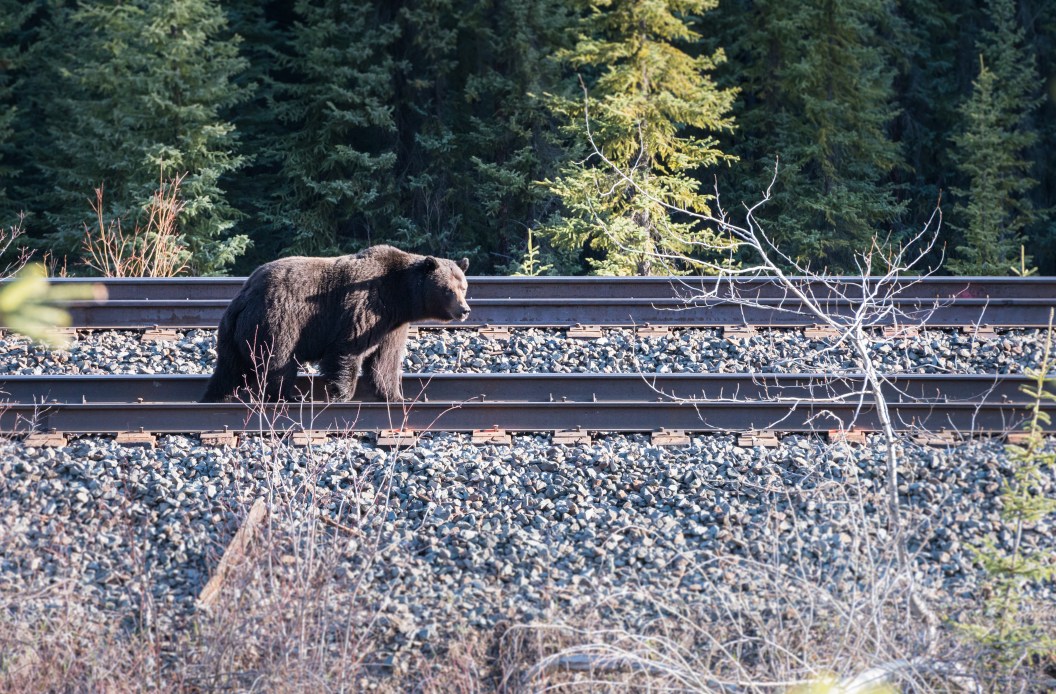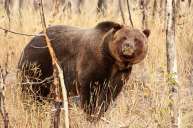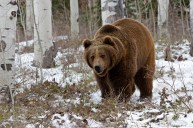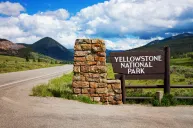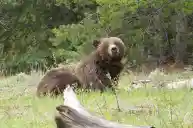Grizzly bears, once nearly extinct in the Lower 48, have been making a slow comeback in Montana, Idaho, Washington, and Wyoming. While conservationists consider overhunting and habitat loss threats to grizzly bear population, a new and lethal combination has come to light: railroads hitting drunken bears.
Since 1980, 63 bears have been killed along a stretch of rail line from Montana to Idaho; three bears have been killed there already this year. Many of the bears are believed to have been made "drunk" from eating fermented grain that spilled from the rail cars. Now, wildlife groups are suing the railroad that owns the rail line, accusing it of illegally killing the intoxicated bears.
Two wildlife groups, WildEarth Guardians and Western Watershed Project, have sued Burlington Northern Santa Fe Railroad Company (BNSF), owner of the rail line in question. The rail line runs from Shelby, Montana, to Sandpoint, Idaho. It cuts across the Northern Continental Divide Ecosystem, one of six recovery zones federally designated for grizzly bears, as well as national forests and the southern border of Glacier National Park.
Chuck Neal, a retired federal ecologist, told Cowboy State Daily that bears are drawn to the train tracks by grain that spills from railcars and then ferments. The bears get drunk, and then "they can, and have, fallen asleep in a drunken stupor right on the tracks," Neal said. "Other times they loiter on the tracks until a train approaches, at high speed, then drunkenly attempt to outrun the train—no can do—and are smashed."
BNSF is well aware of this drunken-bear problem. The railroad company has applied numerous times to the U.S. Fish and Wildlife Service (USFWS) for what's called "incidental take permits." These permits authorize the incidental killing of threatened or endangered species by non-federal organizations that are conducting lawful activities. The permits would exempt the railroad from any penalties for killing drunken grizzly bears.
However, the USFWS has never issued incidental take permits to BNSF. Therefore, wildlife groups are arguing that all of the grizzly bears that have been killed on the rail line have been killed illegally under the Endangered Species Act.
In court documents, WildEarth Guardians and Western Watershed Project outline ways the railroad could reduce bear deaths. These include reducing train speeds around curves and in canyons with few escape routes; warning systems for bears, such as flashing lights and bell sounds; or electrified mats to help keep bears away from trestle bridges where they can't escape trains. The wildlife organizations also want BNSF to take precautions against grain spills and remove other animal carcasses from the tracks to make the rail line less appealing to hungry grizzly bears.
It is unclear at this time what penalties BNSF would face if the suit succeeds.
Thankfully, regardless of the suit's outcome, the problem seems to be an isolated one for grizzly bears in the Lower 48. Frank van Manen, a biologist and head of the Interagency Grizzly Bear Study Team in Yellowstone, told Cowboy State Daily that the railroad threat was an isolated one that hadn't affected Yellowstone grizzlies yet. "We are fortunate to not have that issue as a mortality source in the GYE," he said. "Mortalities from train collisions are also a major issue in several Canadian parks, sometimes representing the main source of mortality." He also noted that vehicles take a much bigger toll on Yellowstone grizzlies. Six grizzlies have been killed this year in Yellowstone by vehicles.
READ MORE: Why Montana's Shipping More Grizzlies Into Yellowstone
